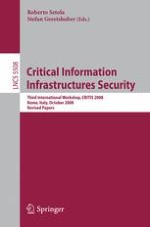2009 | Buch
Critical Information Infrastructure Security
Third International Workshop, CRITIS 2008, Rome, Italy, October13-15, 2008. Revised Papers
herausgegeben von: Roberto Setola, Stefan Geretshuber
Verlag: Springer Berlin Heidelberg
Buchreihe : Lecture Notes in Computer Science
